Buncefield Fire: Health, Safety, Environment, and Management
VerifiedAdded on 2022/08/20
|17
|4987
|14
Report
AI Summary
The report provides a comprehensive analysis of the Buncefield oil terminal fire, which occurred on December 11, 2005, focusing on the health and safety ramifications. It details the health issues arising from the explosion and subsequent fire, including the effects of carbon dioxide and toxic gas inhalation, and the potential for both short-term and long-term health consequences. The report also examines the safety issues, such as corporate leadership and safety culture, the effectiveness of management systems, and hazard identification and risk mitigation. It further discusses the relevant legislative frameworks, including AS/NZS 4801, OHSAS 18001, and ILO conventions, highlighting their roles in promoting occupational safety and health. The report analyzes the management principles applicable to the energy industry and considers the fire's impact on downstream activities. It concludes with recommendations for improving safety and preventing similar incidents in the future, emphasizing the importance of proactive risk assessment and adherence to safety standards. This report is a valuable resource for students studying environmental engineering, safety management, and related fields.
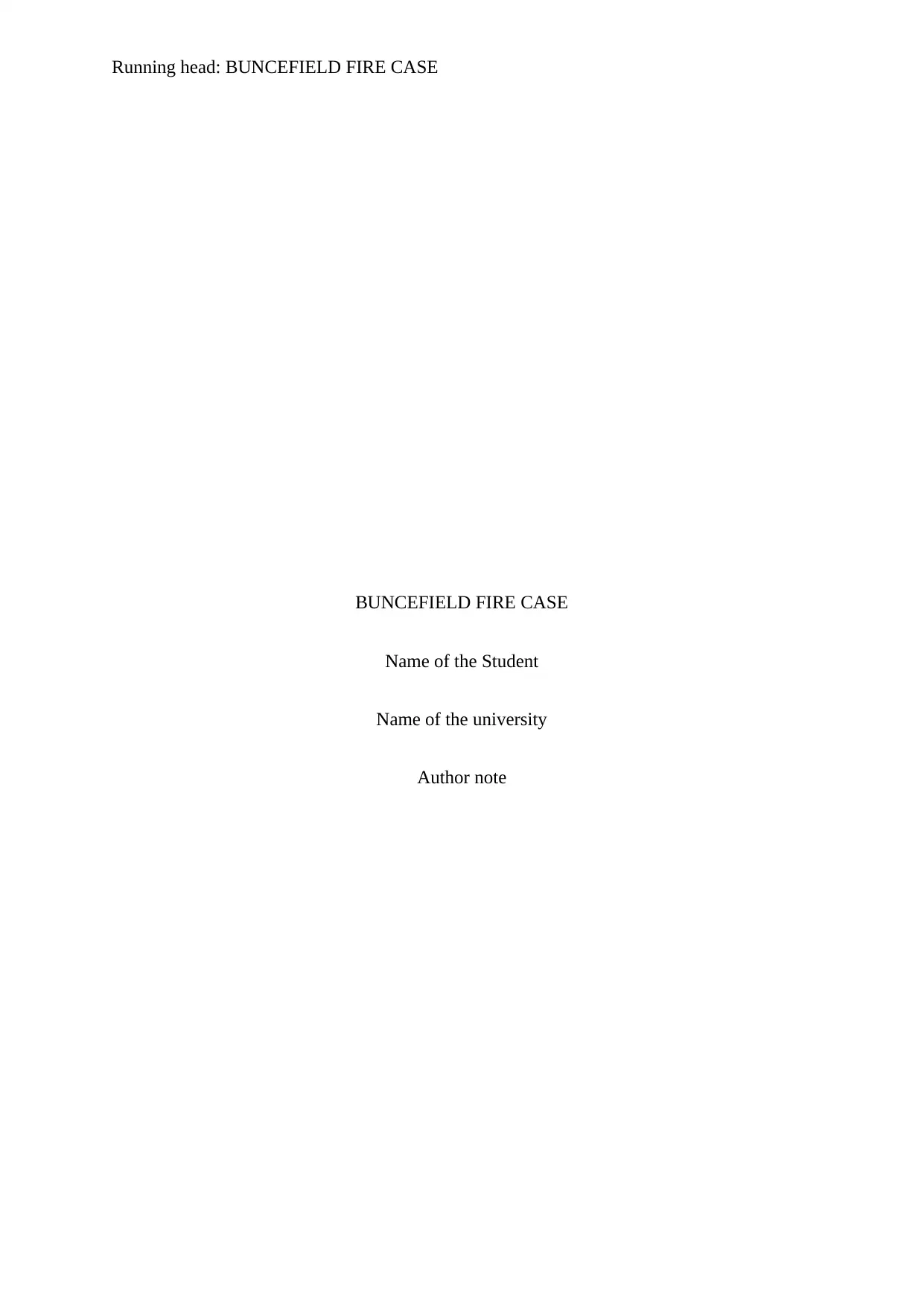
Running head: BUNCEFIELD FIRE CASE
BUNCEFIELD FIRE CASE
Name of the Student
Name of the university
Author note
BUNCEFIELD FIRE CASE
Name of the Student
Name of the university
Author note
Paraphrase This Document
Need a fresh take? Get an instant paraphrase of this document with our AI Paraphraser
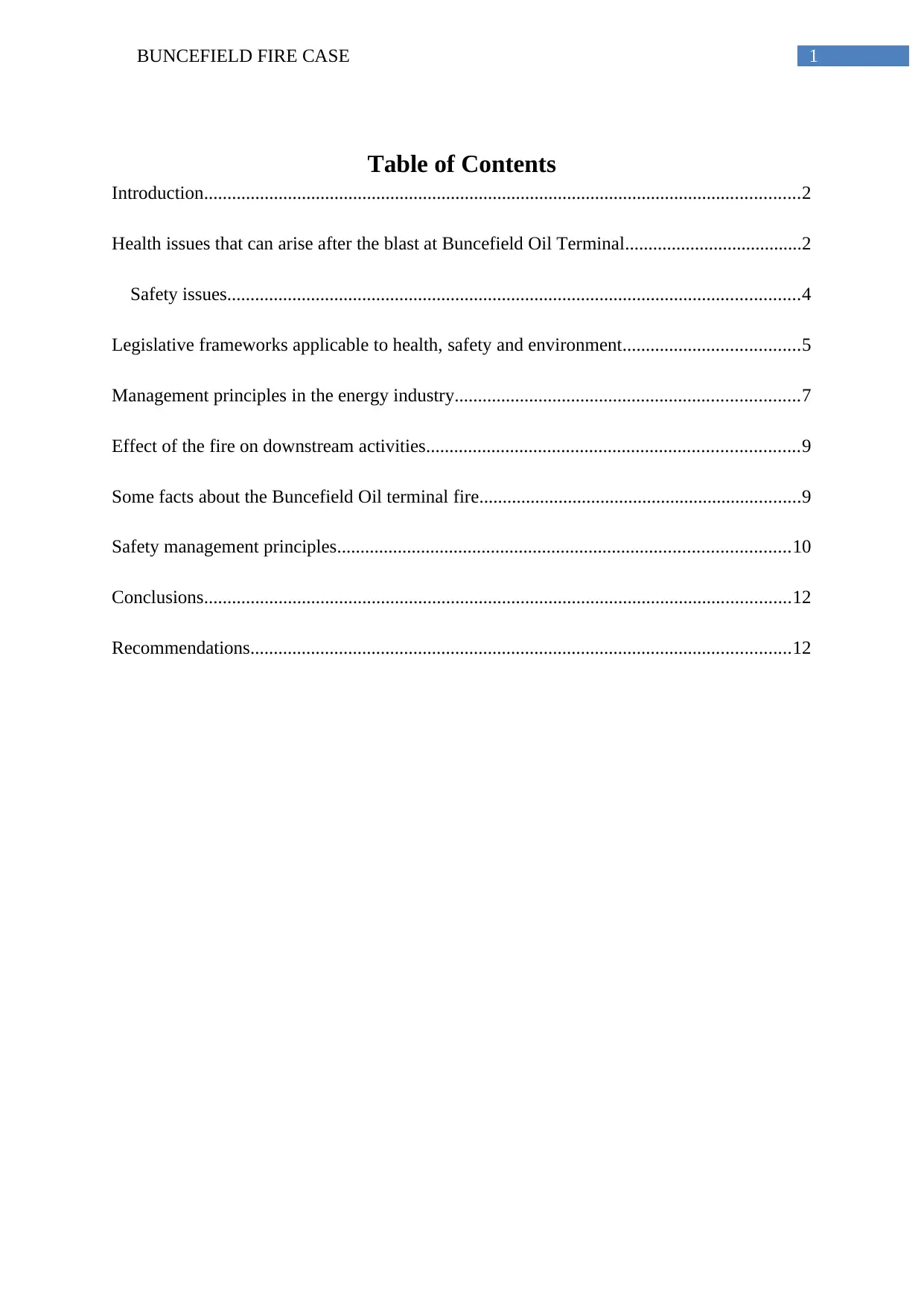
1BUNCEFIELD FIRE CASE
Table of Contents
Introduction................................................................................................................................2
Health issues that can arise after the blast at Buncefield Oil Terminal......................................2
Safety issues...........................................................................................................................4
Legislative frameworks applicable to health, safety and environment......................................5
Management principles in the energy industry..........................................................................7
Effect of the fire on downstream activities................................................................................9
Some facts about the Buncefield Oil terminal fire.....................................................................9
Safety management principles.................................................................................................10
Conclusions..............................................................................................................................12
Recommendations....................................................................................................................12
Table of Contents
Introduction................................................................................................................................2
Health issues that can arise after the blast at Buncefield Oil Terminal......................................2
Safety issues...........................................................................................................................4
Legislative frameworks applicable to health, safety and environment......................................5
Management principles in the energy industry..........................................................................7
Effect of the fire on downstream activities................................................................................9
Some facts about the Buncefield Oil terminal fire.....................................................................9
Safety management principles.................................................................................................10
Conclusions..............................................................................................................................12
Recommendations....................................................................................................................12
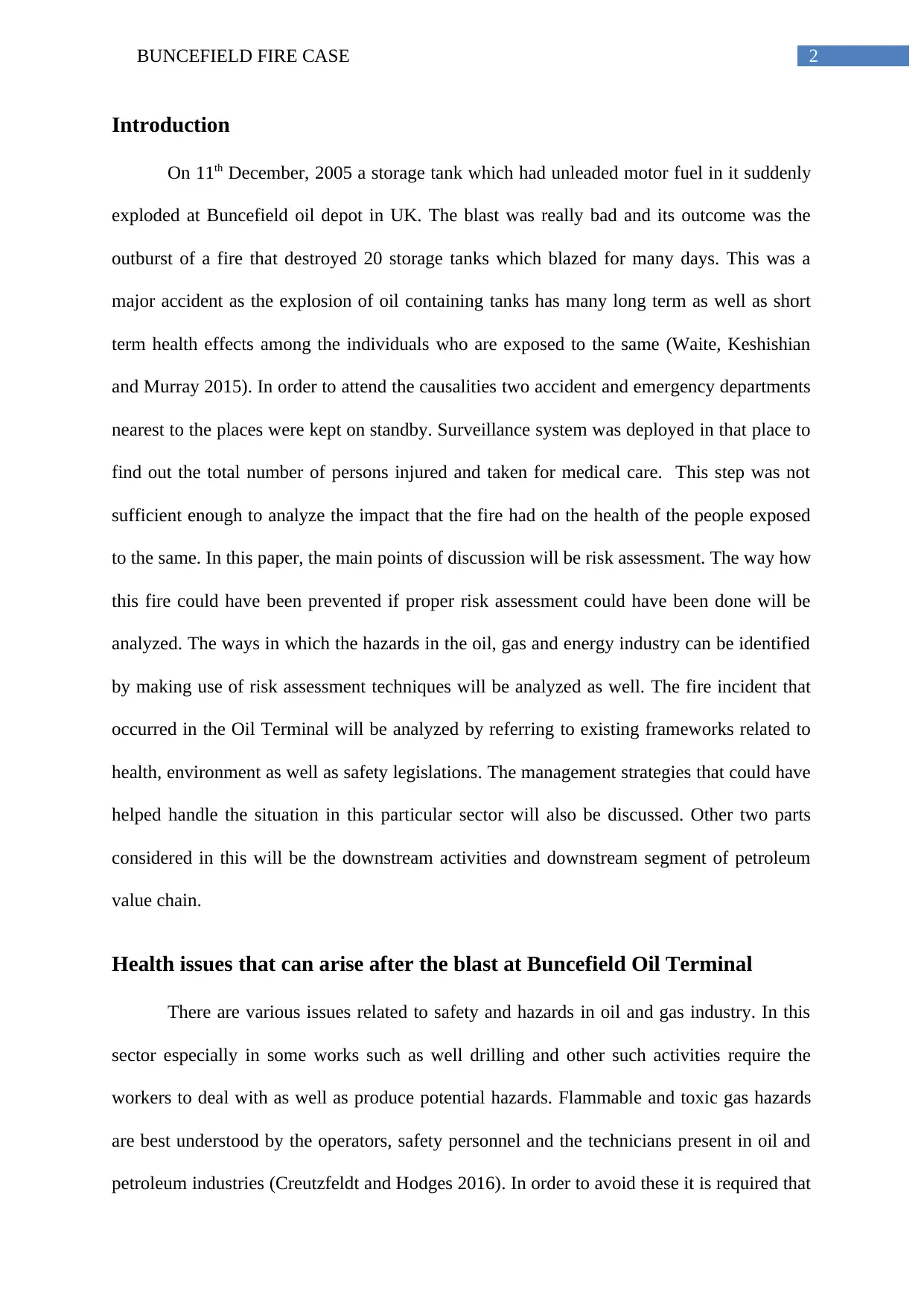
2BUNCEFIELD FIRE CASE
Introduction
On 11th December, 2005 a storage tank which had unleaded motor fuel in it suddenly
exploded at Buncefield oil depot in UK. The blast was really bad and its outcome was the
outburst of a fire that destroyed 20 storage tanks which blazed for many days. This was a
major accident as the explosion of oil containing tanks has many long term as well as short
term health effects among the individuals who are exposed to the same (Waite, Keshishian
and Murray 2015). In order to attend the causalities two accident and emergency departments
nearest to the places were kept on standby. Surveillance system was deployed in that place to
find out the total number of persons injured and taken for medical care. This step was not
sufficient enough to analyze the impact that the fire had on the health of the people exposed
to the same. In this paper, the main points of discussion will be risk assessment. The way how
this fire could have been prevented if proper risk assessment could have been done will be
analyzed. The ways in which the hazards in the oil, gas and energy industry can be identified
by making use of risk assessment techniques will be analyzed as well. The fire incident that
occurred in the Oil Terminal will be analyzed by referring to existing frameworks related to
health, environment as well as safety legislations. The management strategies that could have
helped handle the situation in this particular sector will also be discussed. Other two parts
considered in this will be the downstream activities and downstream segment of petroleum
value chain.
Health issues that can arise after the blast at Buncefield Oil Terminal
There are various issues related to safety and hazards in oil and gas industry. In this
sector especially in some works such as well drilling and other such activities require the
workers to deal with as well as produce potential hazards. Flammable and toxic gas hazards
are best understood by the operators, safety personnel and the technicians present in oil and
petroleum industries (Creutzfeldt and Hodges 2016). In order to avoid these it is required that
Introduction
On 11th December, 2005 a storage tank which had unleaded motor fuel in it suddenly
exploded at Buncefield oil depot in UK. The blast was really bad and its outcome was the
outburst of a fire that destroyed 20 storage tanks which blazed for many days. This was a
major accident as the explosion of oil containing tanks has many long term as well as short
term health effects among the individuals who are exposed to the same (Waite, Keshishian
and Murray 2015). In order to attend the causalities two accident and emergency departments
nearest to the places were kept on standby. Surveillance system was deployed in that place to
find out the total number of persons injured and taken for medical care. This step was not
sufficient enough to analyze the impact that the fire had on the health of the people exposed
to the same. In this paper, the main points of discussion will be risk assessment. The way how
this fire could have been prevented if proper risk assessment could have been done will be
analyzed. The ways in which the hazards in the oil, gas and energy industry can be identified
by making use of risk assessment techniques will be analyzed as well. The fire incident that
occurred in the Oil Terminal will be analyzed by referring to existing frameworks related to
health, environment as well as safety legislations. The management strategies that could have
helped handle the situation in this particular sector will also be discussed. Other two parts
considered in this will be the downstream activities and downstream segment of petroleum
value chain.
Health issues that can arise after the blast at Buncefield Oil Terminal
There are various issues related to safety and hazards in oil and gas industry. In this
sector especially in some works such as well drilling and other such activities require the
workers to deal with as well as produce potential hazards. Flammable and toxic gas hazards
are best understood by the operators, safety personnel and the technicians present in oil and
petroleum industries (Creutzfeldt and Hodges 2016). In order to avoid these it is required that
⊘ This is a preview!⊘
Do you want full access?
Subscribe today to unlock all pages.

Trusted by 1+ million students worldwide
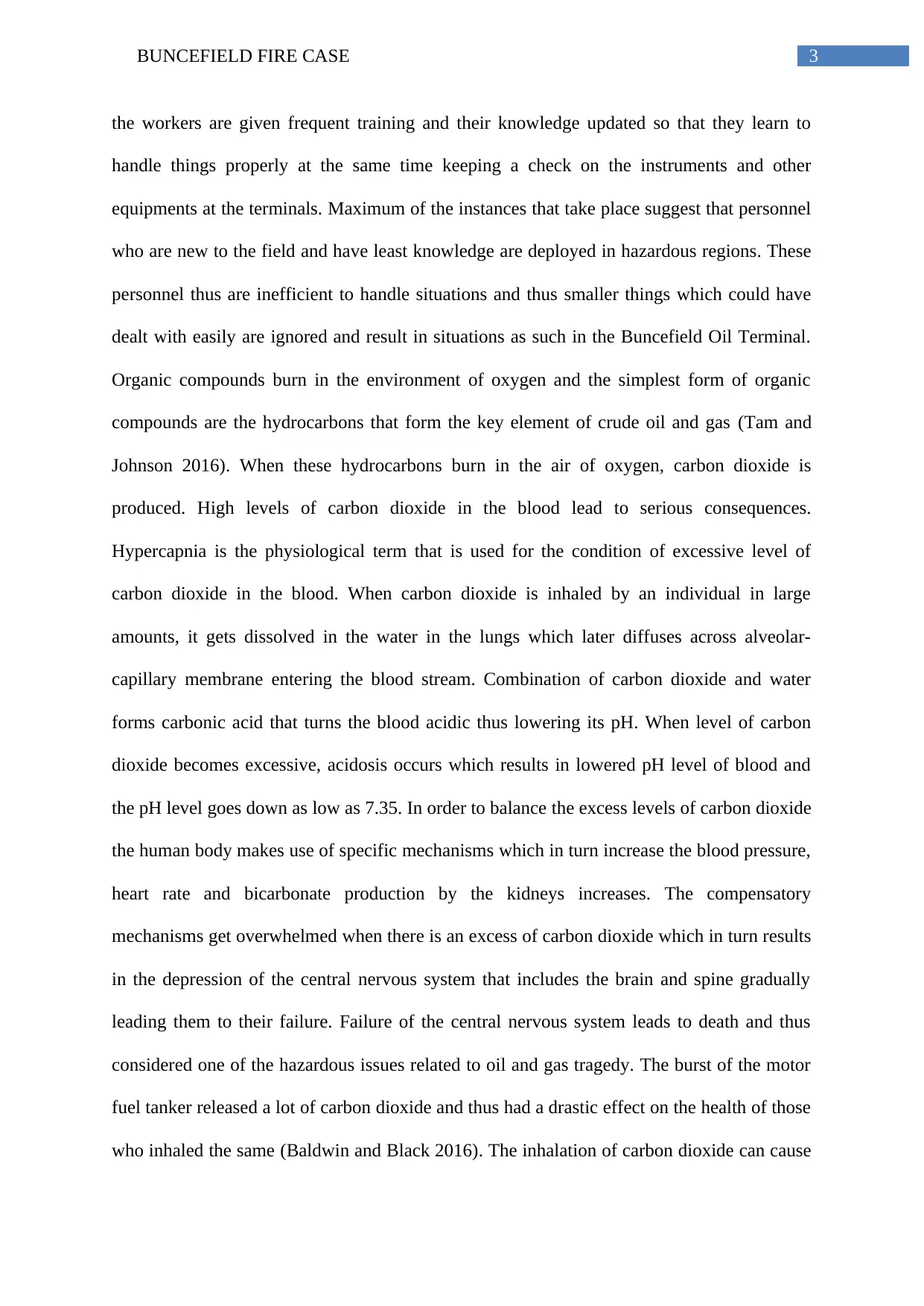
3BUNCEFIELD FIRE CASE
the workers are given frequent training and their knowledge updated so that they learn to
handle things properly at the same time keeping a check on the instruments and other
equipments at the terminals. Maximum of the instances that take place suggest that personnel
who are new to the field and have least knowledge are deployed in hazardous regions. These
personnel thus are inefficient to handle situations and thus smaller things which could have
dealt with easily are ignored and result in situations as such in the Buncefield Oil Terminal.
Organic compounds burn in the environment of oxygen and the simplest form of organic
compounds are the hydrocarbons that form the key element of crude oil and gas (Tam and
Johnson 2016). When these hydrocarbons burn in the air of oxygen, carbon dioxide is
produced. High levels of carbon dioxide in the blood lead to serious consequences.
Hypercapnia is the physiological term that is used for the condition of excessive level of
carbon dioxide in the blood. When carbon dioxide is inhaled by an individual in large
amounts, it gets dissolved in the water in the lungs which later diffuses across alveolar-
capillary membrane entering the blood stream. Combination of carbon dioxide and water
forms carbonic acid that turns the blood acidic thus lowering its pH. When level of carbon
dioxide becomes excessive, acidosis occurs which results in lowered pH level of blood and
the pH level goes down as low as 7.35. In order to balance the excess levels of carbon dioxide
the human body makes use of specific mechanisms which in turn increase the blood pressure,
heart rate and bicarbonate production by the kidneys increases. The compensatory
mechanisms get overwhelmed when there is an excess of carbon dioxide which in turn results
in the depression of the central nervous system that includes the brain and spine gradually
leading them to their failure. Failure of the central nervous system leads to death and thus
considered one of the hazardous issues related to oil and gas tragedy. The burst of the motor
fuel tanker released a lot of carbon dioxide and thus had a drastic effect on the health of those
who inhaled the same (Baldwin and Black 2016). The inhalation of carbon dioxide can cause
the workers are given frequent training and their knowledge updated so that they learn to
handle things properly at the same time keeping a check on the instruments and other
equipments at the terminals. Maximum of the instances that take place suggest that personnel
who are new to the field and have least knowledge are deployed in hazardous regions. These
personnel thus are inefficient to handle situations and thus smaller things which could have
dealt with easily are ignored and result in situations as such in the Buncefield Oil Terminal.
Organic compounds burn in the environment of oxygen and the simplest form of organic
compounds are the hydrocarbons that form the key element of crude oil and gas (Tam and
Johnson 2016). When these hydrocarbons burn in the air of oxygen, carbon dioxide is
produced. High levels of carbon dioxide in the blood lead to serious consequences.
Hypercapnia is the physiological term that is used for the condition of excessive level of
carbon dioxide in the blood. When carbon dioxide is inhaled by an individual in large
amounts, it gets dissolved in the water in the lungs which later diffuses across alveolar-
capillary membrane entering the blood stream. Combination of carbon dioxide and water
forms carbonic acid that turns the blood acidic thus lowering its pH. When level of carbon
dioxide becomes excessive, acidosis occurs which results in lowered pH level of blood and
the pH level goes down as low as 7.35. In order to balance the excess levels of carbon dioxide
the human body makes use of specific mechanisms which in turn increase the blood pressure,
heart rate and bicarbonate production by the kidneys increases. The compensatory
mechanisms get overwhelmed when there is an excess of carbon dioxide which in turn results
in the depression of the central nervous system that includes the brain and spine gradually
leading them to their failure. Failure of the central nervous system leads to death and thus
considered one of the hazardous issues related to oil and gas tragedy. The burst of the motor
fuel tanker released a lot of carbon dioxide and thus had a drastic effect on the health of those
who inhaled the same (Baldwin and Black 2016). The inhalation of carbon dioxide can cause
Paraphrase This Document
Need a fresh take? Get an instant paraphrase of this document with our AI Paraphraser
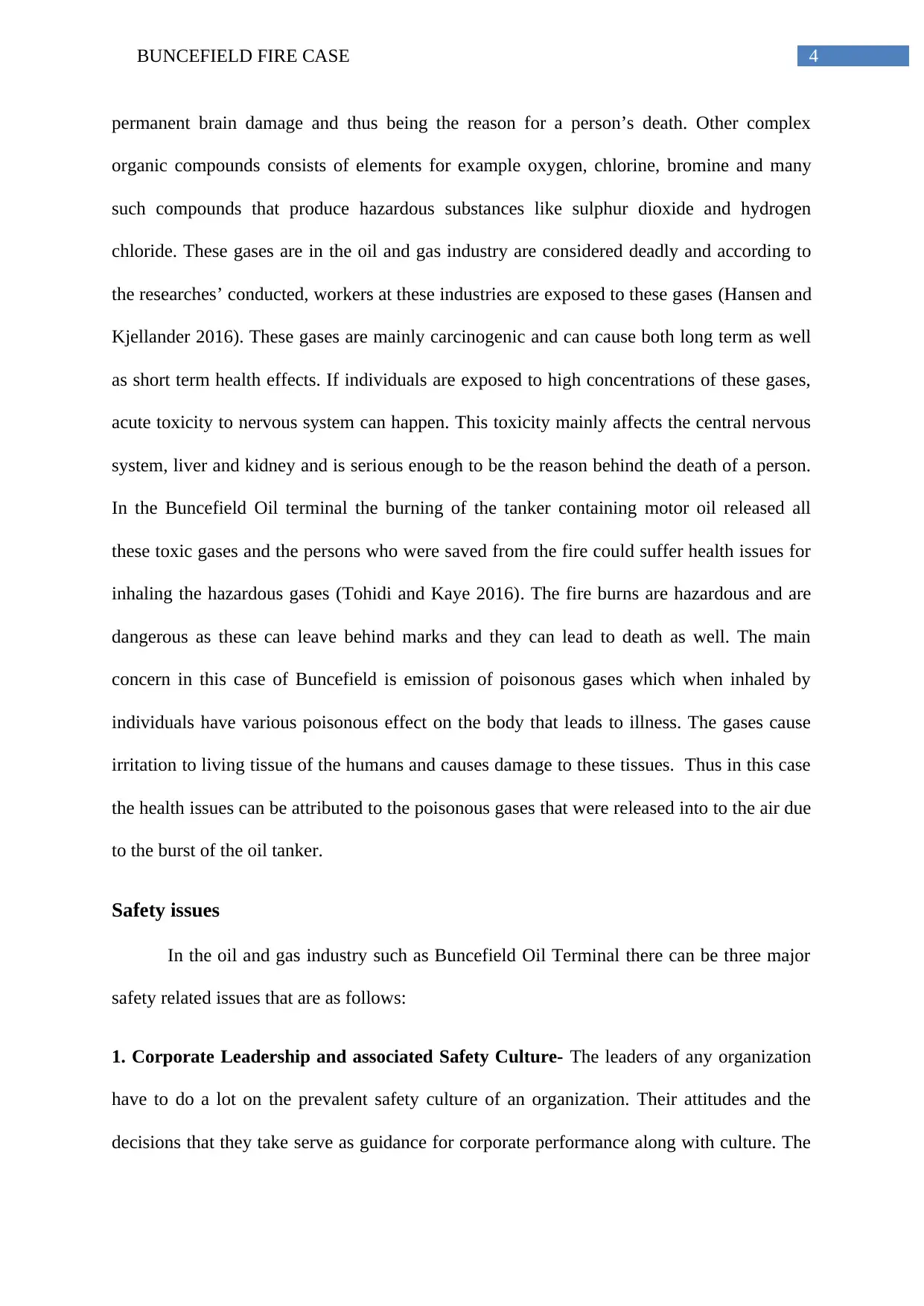
4BUNCEFIELD FIRE CASE
permanent brain damage and thus being the reason for a person’s death. Other complex
organic compounds consists of elements for example oxygen, chlorine, bromine and many
such compounds that produce hazardous substances like sulphur dioxide and hydrogen
chloride. These gases are in the oil and gas industry are considered deadly and according to
the researches’ conducted, workers at these industries are exposed to these gases (Hansen and
Kjellander 2016). These gases are mainly carcinogenic and can cause both long term as well
as short term health effects. If individuals are exposed to high concentrations of these gases,
acute toxicity to nervous system can happen. This toxicity mainly affects the central nervous
system, liver and kidney and is serious enough to be the reason behind the death of a person.
In the Buncefield Oil terminal the burning of the tanker containing motor oil released all
these toxic gases and the persons who were saved from the fire could suffer health issues for
inhaling the hazardous gases (Tohidi and Kaye 2016). The fire burns are hazardous and are
dangerous as these can leave behind marks and they can lead to death as well. The main
concern in this case of Buncefield is emission of poisonous gases which when inhaled by
individuals have various poisonous effect on the body that leads to illness. The gases cause
irritation to living tissue of the humans and causes damage to these tissues. Thus in this case
the health issues can be attributed to the poisonous gases that were released into to the air due
to the burst of the oil tanker.
Safety issues
In the oil and gas industry such as Buncefield Oil Terminal there can be three major
safety related issues that are as follows:
1. Corporate Leadership and associated Safety Culture- The leaders of any organization
have to do a lot on the prevalent safety culture of an organization. Their attitudes and the
decisions that they take serve as guidance for corporate performance along with culture. The
permanent brain damage and thus being the reason for a person’s death. Other complex
organic compounds consists of elements for example oxygen, chlorine, bromine and many
such compounds that produce hazardous substances like sulphur dioxide and hydrogen
chloride. These gases are in the oil and gas industry are considered deadly and according to
the researches’ conducted, workers at these industries are exposed to these gases (Hansen and
Kjellander 2016). These gases are mainly carcinogenic and can cause both long term as well
as short term health effects. If individuals are exposed to high concentrations of these gases,
acute toxicity to nervous system can happen. This toxicity mainly affects the central nervous
system, liver and kidney and is serious enough to be the reason behind the death of a person.
In the Buncefield Oil terminal the burning of the tanker containing motor oil released all
these toxic gases and the persons who were saved from the fire could suffer health issues for
inhaling the hazardous gases (Tohidi and Kaye 2016). The fire burns are hazardous and are
dangerous as these can leave behind marks and they can lead to death as well. The main
concern in this case of Buncefield is emission of poisonous gases which when inhaled by
individuals have various poisonous effect on the body that leads to illness. The gases cause
irritation to living tissue of the humans and causes damage to these tissues. Thus in this case
the health issues can be attributed to the poisonous gases that were released into to the air due
to the burst of the oil tanker.
Safety issues
In the oil and gas industry such as Buncefield Oil Terminal there can be three major
safety related issues that are as follows:
1. Corporate Leadership and associated Safety Culture- The leaders of any organization
have to do a lot on the prevalent safety culture of an organization. Their attitudes and the
decisions that they take serve as guidance for corporate performance along with culture. The
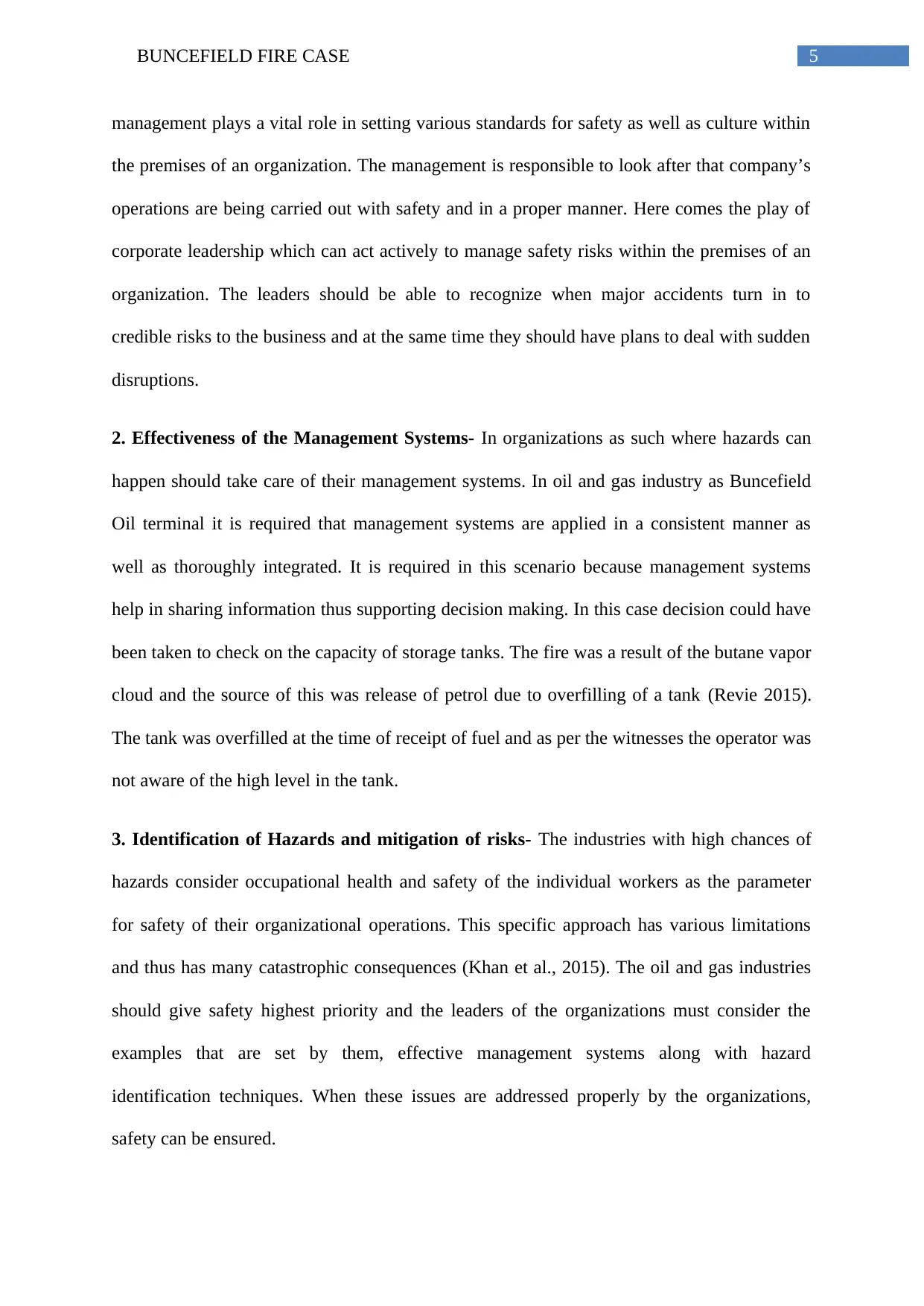
5BUNCEFIELD FIRE CASE
management plays a vital role in setting various standards for safety as well as culture within
the premises of an organization. The management is responsible to look after that company’s
operations are being carried out with safety and in a proper manner. Here comes the play of
corporate leadership which can act actively to manage safety risks within the premises of an
organization. The leaders should be able to recognize when major accidents turn in to
credible risks to the business and at the same time they should have plans to deal with sudden
disruptions.
2. Effectiveness of the Management Systems- In organizations as such where hazards can
happen should take care of their management systems. In oil and gas industry as Buncefield
Oil terminal it is required that management systems are applied in a consistent manner as
well as thoroughly integrated. It is required in this scenario because management systems
help in sharing information thus supporting decision making. In this case decision could have
been taken to check on the capacity of storage tanks. The fire was a result of the butane vapor
cloud and the source of this was release of petrol due to overfilling of a tank (Revie 2015).
The tank was overfilled at the time of receipt of fuel and as per the witnesses the operator was
not aware of the high level in the tank.
3. Identification of Hazards and mitigation of risks- The industries with high chances of
hazards consider occupational health and safety of the individual workers as the parameter
for safety of their organizational operations. This specific approach has various limitations
and thus has many catastrophic consequences (Khan et al., 2015). The oil and gas industries
should give safety highest priority and the leaders of the organizations must consider the
examples that are set by them, effective management systems along with hazard
identification techniques. When these issues are addressed properly by the organizations,
safety can be ensured.
management plays a vital role in setting various standards for safety as well as culture within
the premises of an organization. The management is responsible to look after that company’s
operations are being carried out with safety and in a proper manner. Here comes the play of
corporate leadership which can act actively to manage safety risks within the premises of an
organization. The leaders should be able to recognize when major accidents turn in to
credible risks to the business and at the same time they should have plans to deal with sudden
disruptions.
2. Effectiveness of the Management Systems- In organizations as such where hazards can
happen should take care of their management systems. In oil and gas industry as Buncefield
Oil terminal it is required that management systems are applied in a consistent manner as
well as thoroughly integrated. It is required in this scenario because management systems
help in sharing information thus supporting decision making. In this case decision could have
been taken to check on the capacity of storage tanks. The fire was a result of the butane vapor
cloud and the source of this was release of petrol due to overfilling of a tank (Revie 2015).
The tank was overfilled at the time of receipt of fuel and as per the witnesses the operator was
not aware of the high level in the tank.
3. Identification of Hazards and mitigation of risks- The industries with high chances of
hazards consider occupational health and safety of the individual workers as the parameter
for safety of their organizational operations. This specific approach has various limitations
and thus has many catastrophic consequences (Khan et al., 2015). The oil and gas industries
should give safety highest priority and the leaders of the organizations must consider the
examples that are set by them, effective management systems along with hazard
identification techniques. When these issues are addressed properly by the organizations,
safety can be ensured.
⊘ This is a preview!⊘
Do you want full access?
Subscribe today to unlock all pages.

Trusted by 1+ million students worldwide
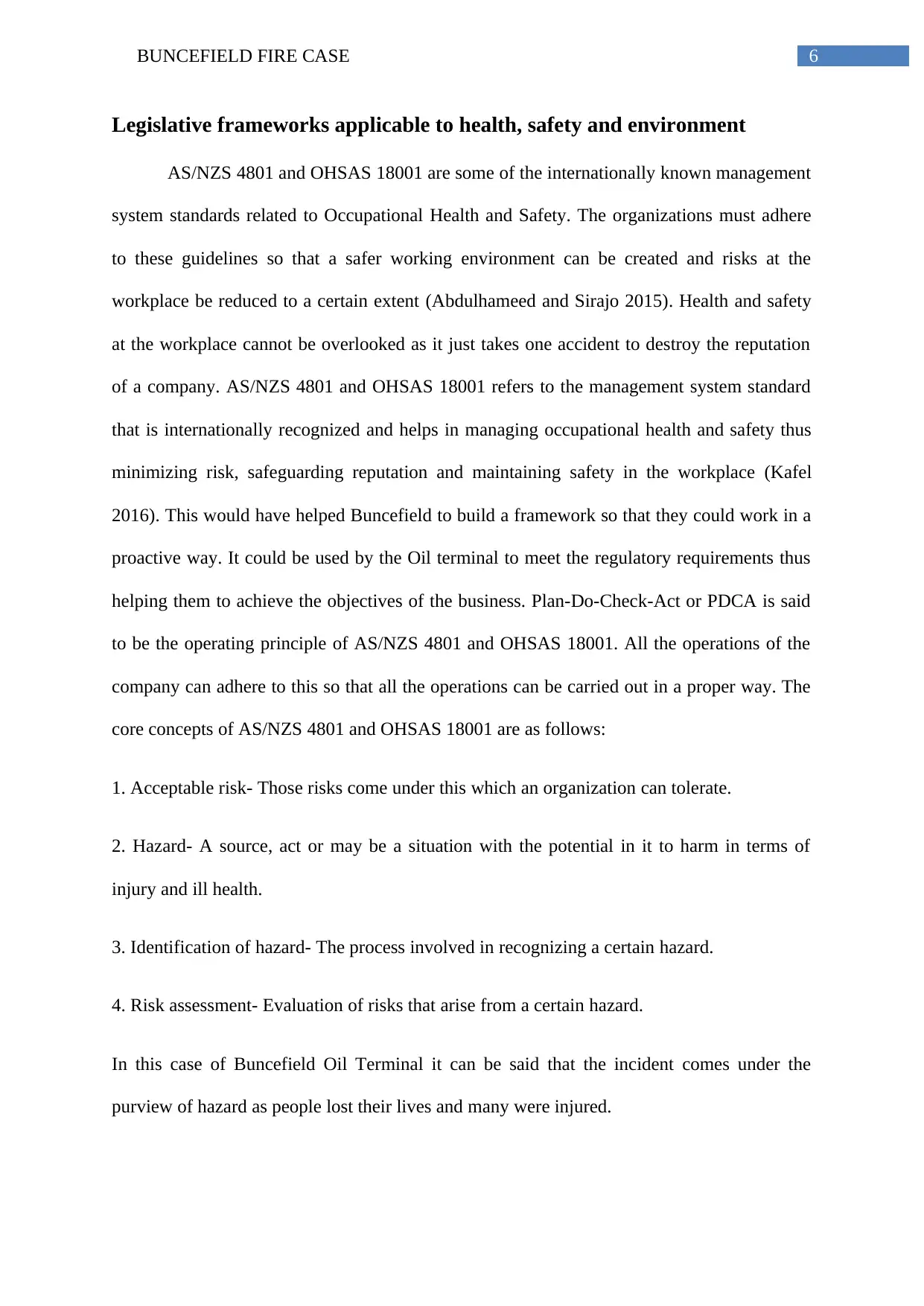
6BUNCEFIELD FIRE CASE
Legislative frameworks applicable to health, safety and environment
AS/NZS 4801 and OHSAS 18001 are some of the internationally known management
system standards related to Occupational Health and Safety. The organizations must adhere
to these guidelines so that a safer working environment can be created and risks at the
workplace be reduced to a certain extent (Abdulhameed and Sirajo 2015). Health and safety
at the workplace cannot be overlooked as it just takes one accident to destroy the reputation
of a company. AS/NZS 4801 and OHSAS 18001 refers to the management system standard
that is internationally recognized and helps in managing occupational health and safety thus
minimizing risk, safeguarding reputation and maintaining safety in the workplace (Kafel
2016). This would have helped Buncefield to build a framework so that they could work in a
proactive way. It could be used by the Oil terminal to meet the regulatory requirements thus
helping them to achieve the objectives of the business. Plan-Do-Check-Act or PDCA is said
to be the operating principle of AS/NZS 4801 and OHSAS 18001. All the operations of the
company can adhere to this so that all the operations can be carried out in a proper way. The
core concepts of AS/NZS 4801 and OHSAS 18001 are as follows:
1. Acceptable risk- Those risks come under this which an organization can tolerate.
2. Hazard- A source, act or may be a situation with the potential in it to harm in terms of
injury and ill health.
3. Identification of hazard- The process involved in recognizing a certain hazard.
4. Risk assessment- Evaluation of risks that arise from a certain hazard.
In this case of Buncefield Oil Terminal it can be said that the incident comes under the
purview of hazard as people lost their lives and many were injured.
Legislative frameworks applicable to health, safety and environment
AS/NZS 4801 and OHSAS 18001 are some of the internationally known management
system standards related to Occupational Health and Safety. The organizations must adhere
to these guidelines so that a safer working environment can be created and risks at the
workplace be reduced to a certain extent (Abdulhameed and Sirajo 2015). Health and safety
at the workplace cannot be overlooked as it just takes one accident to destroy the reputation
of a company. AS/NZS 4801 and OHSAS 18001 refers to the management system standard
that is internationally recognized and helps in managing occupational health and safety thus
minimizing risk, safeguarding reputation and maintaining safety in the workplace (Kafel
2016). This would have helped Buncefield to build a framework so that they could work in a
proactive way. It could be used by the Oil terminal to meet the regulatory requirements thus
helping them to achieve the objectives of the business. Plan-Do-Check-Act or PDCA is said
to be the operating principle of AS/NZS 4801 and OHSAS 18001. All the operations of the
company can adhere to this so that all the operations can be carried out in a proper way. The
core concepts of AS/NZS 4801 and OHSAS 18001 are as follows:
1. Acceptable risk- Those risks come under this which an organization can tolerate.
2. Hazard- A source, act or may be a situation with the potential in it to harm in terms of
injury and ill health.
3. Identification of hazard- The process involved in recognizing a certain hazard.
4. Risk assessment- Evaluation of risks that arise from a certain hazard.
In this case of Buncefield Oil Terminal it can be said that the incident comes under the
purview of hazard as people lost their lives and many were injured.
Paraphrase This Document
Need a fresh take? Get an instant paraphrase of this document with our AI Paraphraser
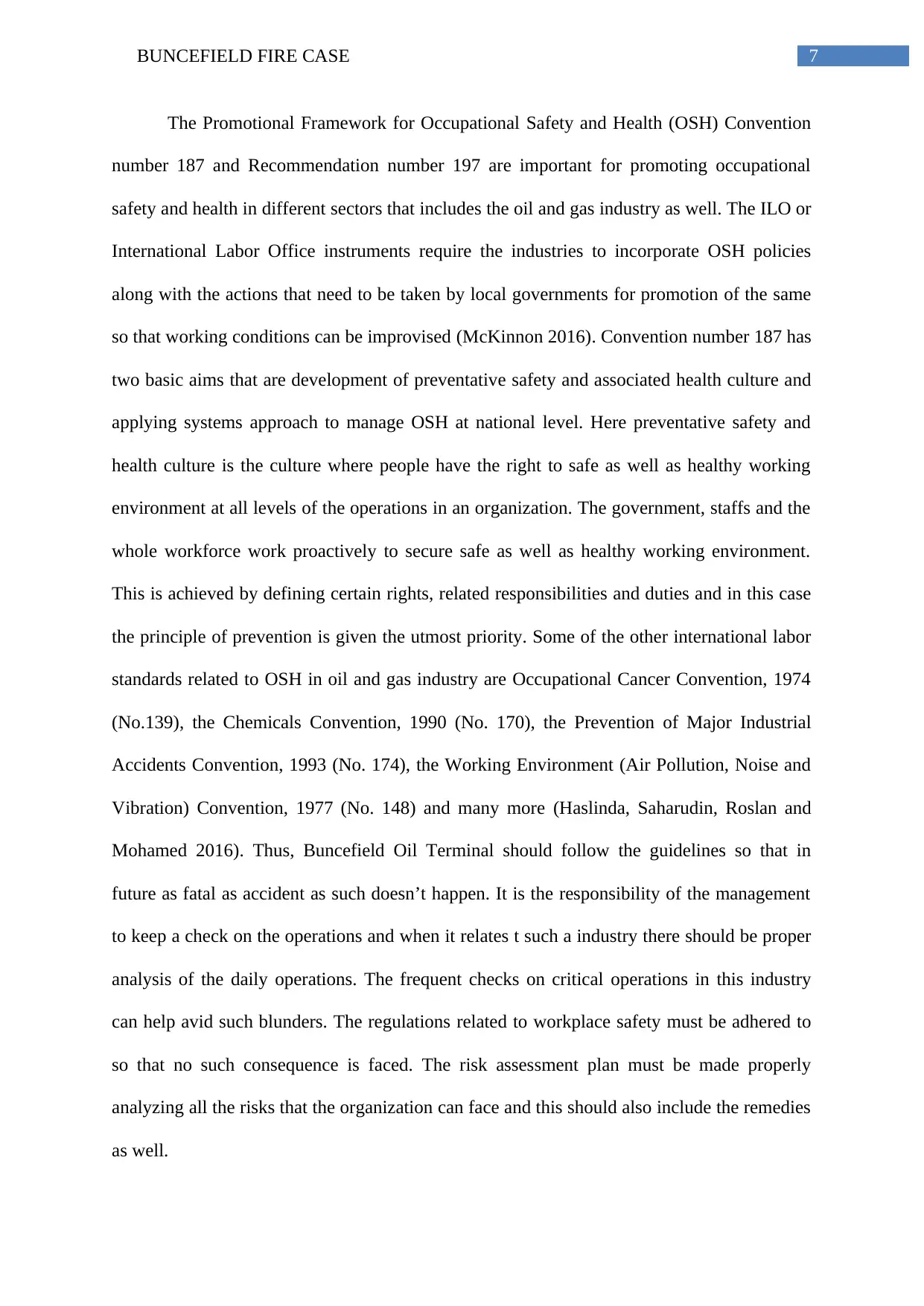
7BUNCEFIELD FIRE CASE
The Promotional Framework for Occupational Safety and Health (OSH) Convention
number 187 and Recommendation number 197 are important for promoting occupational
safety and health in different sectors that includes the oil and gas industry as well. The ILO or
International Labor Office instruments require the industries to incorporate OSH policies
along with the actions that need to be taken by local governments for promotion of the same
so that working conditions can be improvised (McKinnon 2016). Convention number 187 has
two basic aims that are development of preventative safety and associated health culture and
applying systems approach to manage OSH at national level. Here preventative safety and
health culture is the culture where people have the right to safe as well as healthy working
environment at all levels of the operations in an organization. The government, staffs and the
whole workforce work proactively to secure safe as well as healthy working environment.
This is achieved by defining certain rights, related responsibilities and duties and in this case
the principle of prevention is given the utmost priority. Some of the other international labor
standards related to OSH in oil and gas industry are Occupational Cancer Convention, 1974
(No.139), the Chemicals Convention, 1990 (No. 170), the Prevention of Major Industrial
Accidents Convention, 1993 (No. 174), the Working Environment (Air Pollution, Noise and
Vibration) Convention, 1977 (No. 148) and many more (Haslinda, Saharudin, Roslan and
Mohamed 2016). Thus, Buncefield Oil Terminal should follow the guidelines so that in
future as fatal as accident as such doesn’t happen. It is the responsibility of the management
to keep a check on the operations and when it relates t such a industry there should be proper
analysis of the daily operations. The frequent checks on critical operations in this industry
can help avid such blunders. The regulations related to workplace safety must be adhered to
so that no such consequence is faced. The risk assessment plan must be made properly
analyzing all the risks that the organization can face and this should also include the remedies
as well.
The Promotional Framework for Occupational Safety and Health (OSH) Convention
number 187 and Recommendation number 197 are important for promoting occupational
safety and health in different sectors that includes the oil and gas industry as well. The ILO or
International Labor Office instruments require the industries to incorporate OSH policies
along with the actions that need to be taken by local governments for promotion of the same
so that working conditions can be improvised (McKinnon 2016). Convention number 187 has
two basic aims that are development of preventative safety and associated health culture and
applying systems approach to manage OSH at national level. Here preventative safety and
health culture is the culture where people have the right to safe as well as healthy working
environment at all levels of the operations in an organization. The government, staffs and the
whole workforce work proactively to secure safe as well as healthy working environment.
This is achieved by defining certain rights, related responsibilities and duties and in this case
the principle of prevention is given the utmost priority. Some of the other international labor
standards related to OSH in oil and gas industry are Occupational Cancer Convention, 1974
(No.139), the Chemicals Convention, 1990 (No. 170), the Prevention of Major Industrial
Accidents Convention, 1993 (No. 174), the Working Environment (Air Pollution, Noise and
Vibration) Convention, 1977 (No. 148) and many more (Haslinda, Saharudin, Roslan and
Mohamed 2016). Thus, Buncefield Oil Terminal should follow the guidelines so that in
future as fatal as accident as such doesn’t happen. It is the responsibility of the management
to keep a check on the operations and when it relates t such a industry there should be proper
analysis of the daily operations. The frequent checks on critical operations in this industry
can help avid such blunders. The regulations related to workplace safety must be adhered to
so that no such consequence is faced. The risk assessment plan must be made properly
analyzing all the risks that the organization can face and this should also include the remedies
as well.
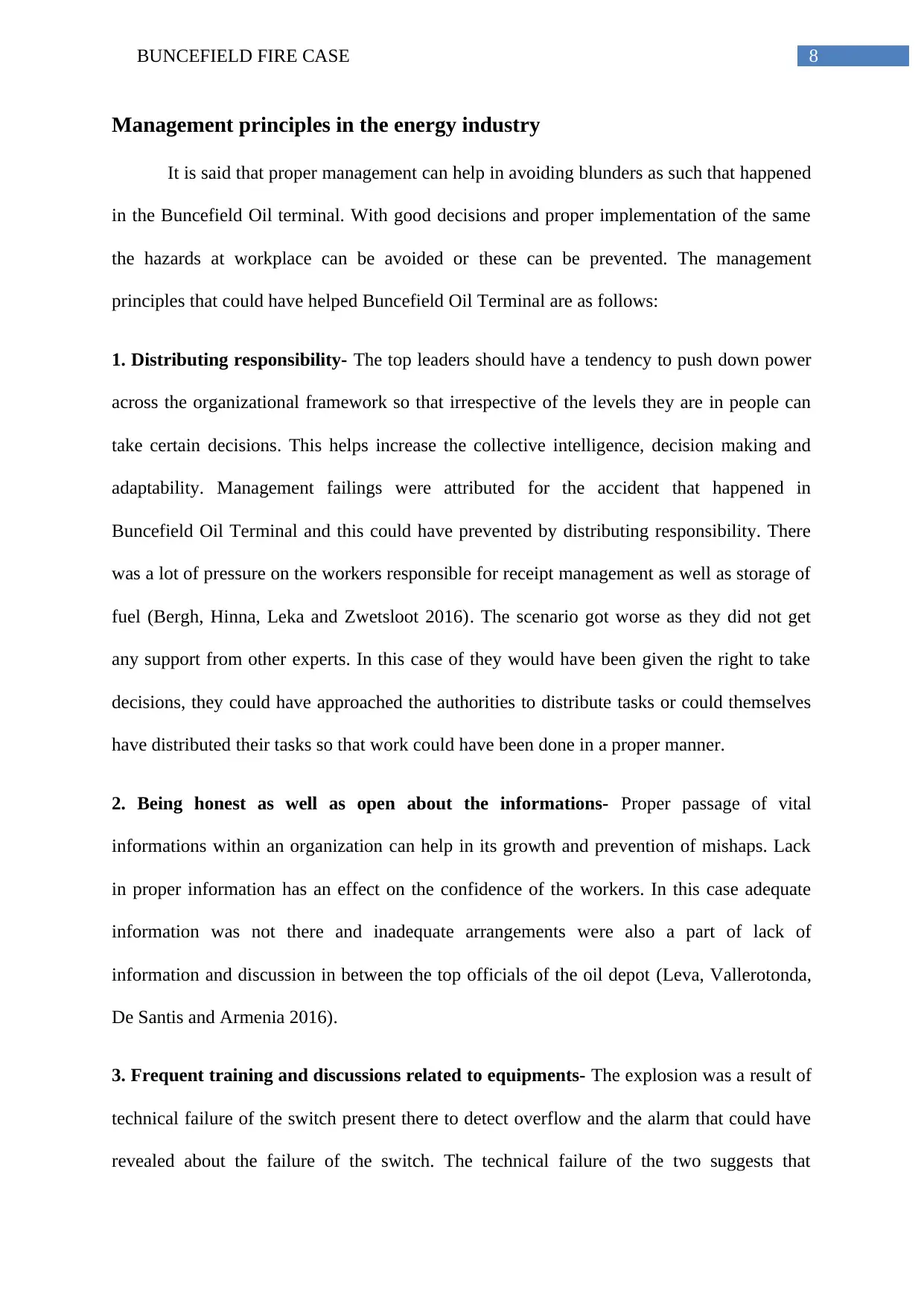
8BUNCEFIELD FIRE CASE
Management principles in the energy industry
It is said that proper management can help in avoiding blunders as such that happened
in the Buncefield Oil terminal. With good decisions and proper implementation of the same
the hazards at workplace can be avoided or these can be prevented. The management
principles that could have helped Buncefield Oil Terminal are as follows:
1. Distributing responsibility- The top leaders should have a tendency to push down power
across the organizational framework so that irrespective of the levels they are in people can
take certain decisions. This helps increase the collective intelligence, decision making and
adaptability. Management failings were attributed for the accident that happened in
Buncefield Oil Terminal and this could have prevented by distributing responsibility. There
was a lot of pressure on the workers responsible for receipt management as well as storage of
fuel (Bergh, Hinna, Leka and Zwetsloot 2016). The scenario got worse as they did not get
any support from other experts. In this case of they would have been given the right to take
decisions, they could have approached the authorities to distribute tasks or could themselves
have distributed their tasks so that work could have been done in a proper manner.
2. Being honest as well as open about the informations- Proper passage of vital
informations within an organization can help in its growth and prevention of mishaps. Lack
in proper information has an effect on the confidence of the workers. In this case adequate
information was not there and inadequate arrangements were also a part of lack of
information and discussion in between the top officials of the oil depot (Leva, Vallerotonda,
De Santis and Armenia 2016).
3. Frequent training and discussions related to equipments- The explosion was a result of
technical failure of the switch present there to detect overflow and the alarm that could have
revealed about the failure of the switch. The technical failure of the two suggests that
Management principles in the energy industry
It is said that proper management can help in avoiding blunders as such that happened
in the Buncefield Oil terminal. With good decisions and proper implementation of the same
the hazards at workplace can be avoided or these can be prevented. The management
principles that could have helped Buncefield Oil Terminal are as follows:
1. Distributing responsibility- The top leaders should have a tendency to push down power
across the organizational framework so that irrespective of the levels they are in people can
take certain decisions. This helps increase the collective intelligence, decision making and
adaptability. Management failings were attributed for the accident that happened in
Buncefield Oil Terminal and this could have prevented by distributing responsibility. There
was a lot of pressure on the workers responsible for receipt management as well as storage of
fuel (Bergh, Hinna, Leka and Zwetsloot 2016). The scenario got worse as they did not get
any support from other experts. In this case of they would have been given the right to take
decisions, they could have approached the authorities to distribute tasks or could themselves
have distributed their tasks so that work could have been done in a proper manner.
2. Being honest as well as open about the informations- Proper passage of vital
informations within an organization can help in its growth and prevention of mishaps. Lack
in proper information has an effect on the confidence of the workers. In this case adequate
information was not there and inadequate arrangements were also a part of lack of
information and discussion in between the top officials of the oil depot (Leva, Vallerotonda,
De Santis and Armenia 2016).
3. Frequent training and discussions related to equipments- The explosion was a result of
technical failure of the switch present there to detect overflow and the alarm that could have
revealed about the failure of the switch. The technical failure of the two suggests that
⊘ This is a preview!⊘
Do you want full access?
Subscribe today to unlock all pages.

Trusted by 1+ million students worldwide
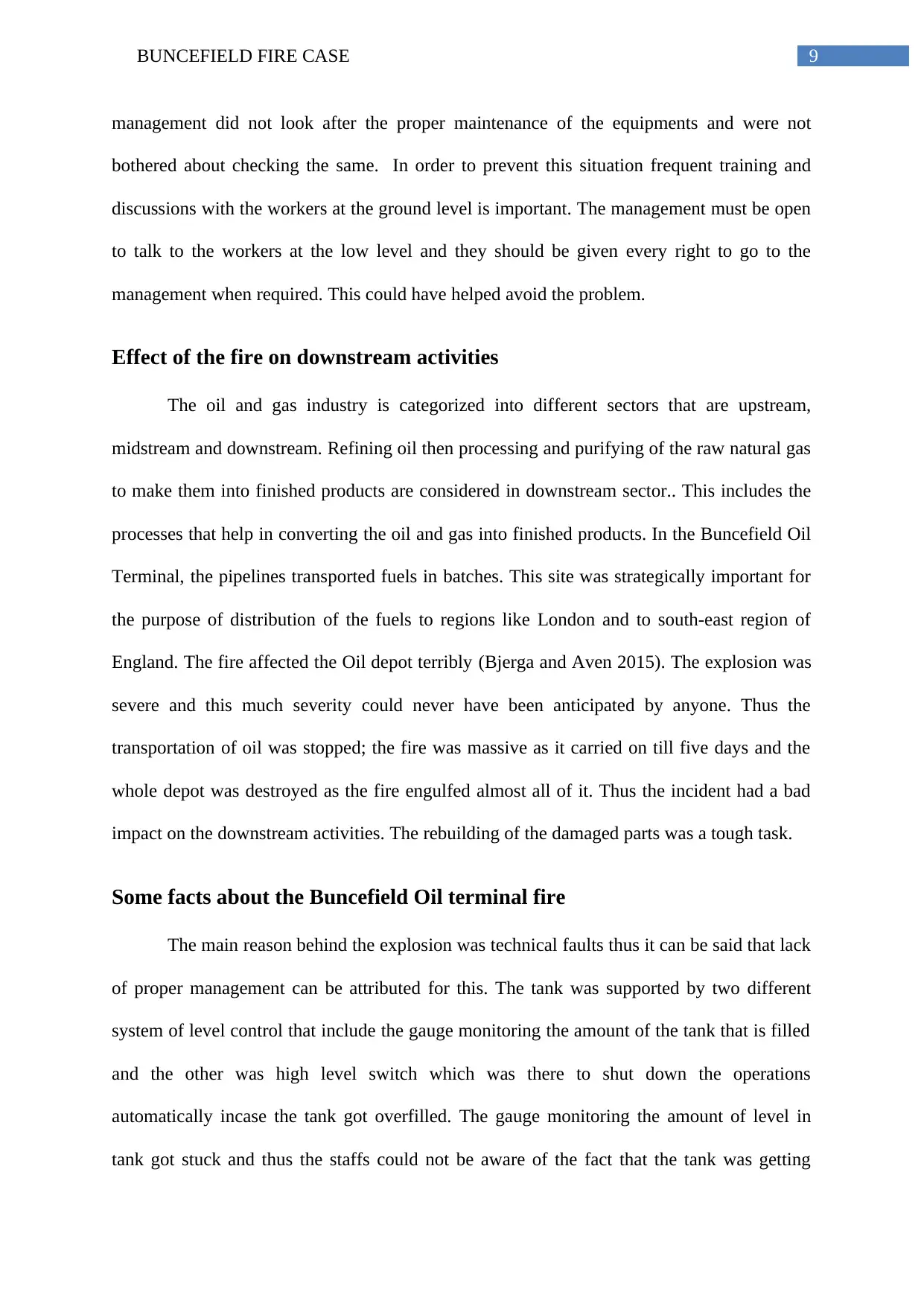
9BUNCEFIELD FIRE CASE
management did not look after the proper maintenance of the equipments and were not
bothered about checking the same. In order to prevent this situation frequent training and
discussions with the workers at the ground level is important. The management must be open
to talk to the workers at the low level and they should be given every right to go to the
management when required. This could have helped avoid the problem.
Effect of the fire on downstream activities
The oil and gas industry is categorized into different sectors that are upstream,
midstream and downstream. Refining oil then processing and purifying of the raw natural gas
to make them into finished products are considered in downstream sector.. This includes the
processes that help in converting the oil and gas into finished products. In the Buncefield Oil
Terminal, the pipelines transported fuels in batches. This site was strategically important for
the purpose of distribution of the fuels to regions like London and to south-east region of
England. The fire affected the Oil depot terribly (Bjerga and Aven 2015). The explosion was
severe and this much severity could never have been anticipated by anyone. Thus the
transportation of oil was stopped; the fire was massive as it carried on till five days and the
whole depot was destroyed as the fire engulfed almost all of it. Thus the incident had a bad
impact on the downstream activities. The rebuilding of the damaged parts was a tough task.
Some facts about the Buncefield Oil terminal fire
The main reason behind the explosion was technical faults thus it can be said that lack
of proper management can be attributed for this. The tank was supported by two different
system of level control that include the gauge monitoring the amount of the tank that is filled
and the other was high level switch which was there to shut down the operations
automatically incase the tank got overfilled. The gauge monitoring the amount of level in
tank got stuck and thus the staffs could not be aware of the fact that the tank was getting
management did not look after the proper maintenance of the equipments and were not
bothered about checking the same. In order to prevent this situation frequent training and
discussions with the workers at the ground level is important. The management must be open
to talk to the workers at the low level and they should be given every right to go to the
management when required. This could have helped avoid the problem.
Effect of the fire on downstream activities
The oil and gas industry is categorized into different sectors that are upstream,
midstream and downstream. Refining oil then processing and purifying of the raw natural gas
to make them into finished products are considered in downstream sector.. This includes the
processes that help in converting the oil and gas into finished products. In the Buncefield Oil
Terminal, the pipelines transported fuels in batches. This site was strategically important for
the purpose of distribution of the fuels to regions like London and to south-east region of
England. The fire affected the Oil depot terribly (Bjerga and Aven 2015). The explosion was
severe and this much severity could never have been anticipated by anyone. Thus the
transportation of oil was stopped; the fire was massive as it carried on till five days and the
whole depot was destroyed as the fire engulfed almost all of it. Thus the incident had a bad
impact on the downstream activities. The rebuilding of the damaged parts was a tough task.
Some facts about the Buncefield Oil terminal fire
The main reason behind the explosion was technical faults thus it can be said that lack
of proper management can be attributed for this. The tank was supported by two different
system of level control that include the gauge monitoring the amount of the tank that is filled
and the other was high level switch which was there to shut down the operations
automatically incase the tank got overfilled. The gauge monitoring the amount of level in
tank got stuck and thus the staffs could not be aware of the fact that the tank was getting
Paraphrase This Document
Need a fresh take? Get an instant paraphrase of this document with our AI Paraphraser
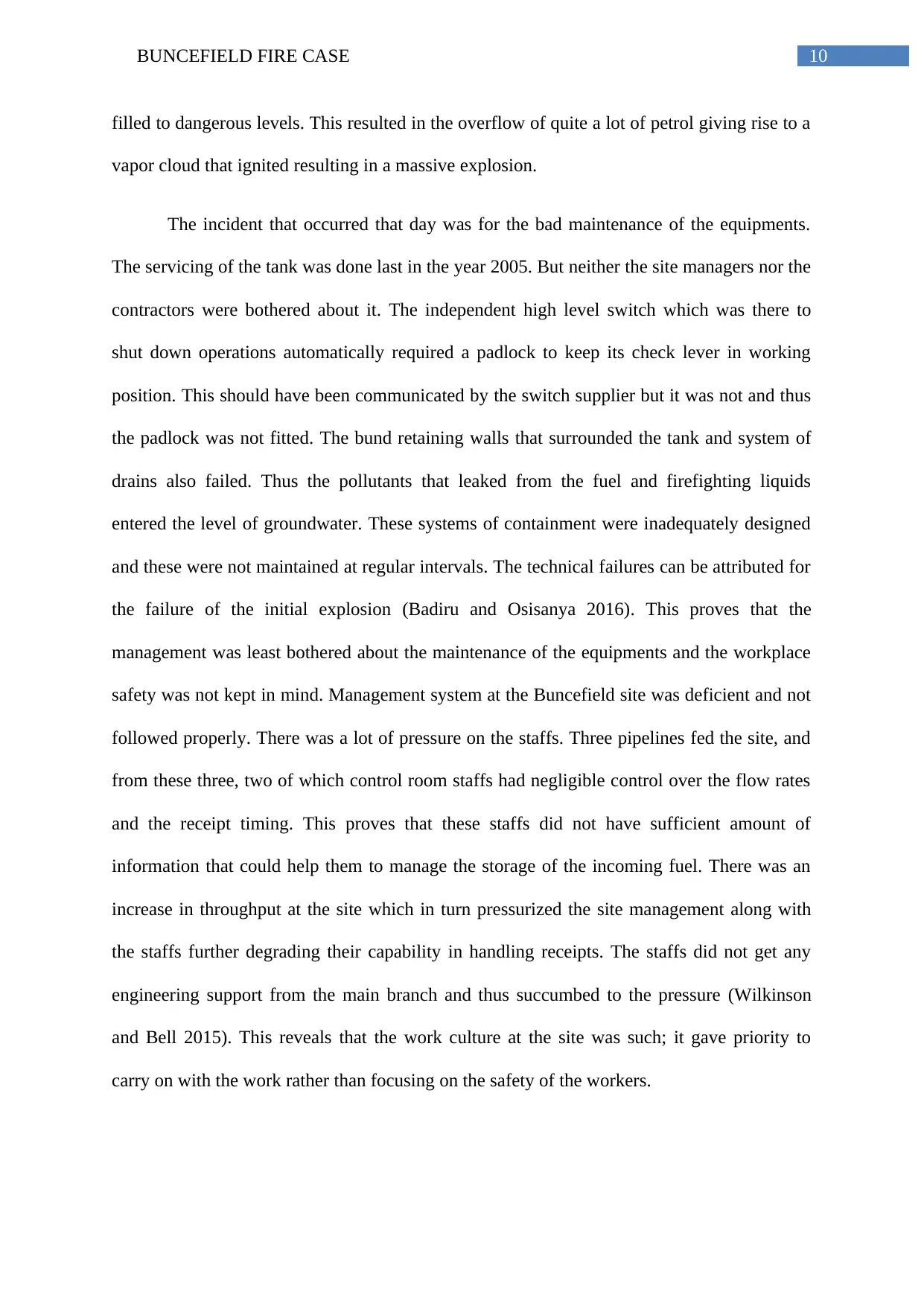
10BUNCEFIELD FIRE CASE
filled to dangerous levels. This resulted in the overflow of quite a lot of petrol giving rise to a
vapor cloud that ignited resulting in a massive explosion.
The incident that occurred that day was for the bad maintenance of the equipments.
The servicing of the tank was done last in the year 2005. But neither the site managers nor the
contractors were bothered about it. The independent high level switch which was there to
shut down operations automatically required a padlock to keep its check lever in working
position. This should have been communicated by the switch supplier but it was not and thus
the padlock was not fitted. The bund retaining walls that surrounded the tank and system of
drains also failed. Thus the pollutants that leaked from the fuel and firefighting liquids
entered the level of groundwater. These systems of containment were inadequately designed
and these were not maintained at regular intervals. The technical failures can be attributed for
the failure of the initial explosion (Badiru and Osisanya 2016). This proves that the
management was least bothered about the maintenance of the equipments and the workplace
safety was not kept in mind. Management system at the Buncefield site was deficient and not
followed properly. There was a lot of pressure on the staffs. Three pipelines fed the site, and
from these three, two of which control room staffs had negligible control over the flow rates
and the receipt timing. This proves that these staffs did not have sufficient amount of
information that could help them to manage the storage of the incoming fuel. There was an
increase in throughput at the site which in turn pressurized the site management along with
the staffs further degrading their capability in handling receipts. The staffs did not get any
engineering support from the main branch and thus succumbed to the pressure (Wilkinson
and Bell 2015). This reveals that the work culture at the site was such; it gave priority to
carry on with the work rather than focusing on the safety of the workers.
filled to dangerous levels. This resulted in the overflow of quite a lot of petrol giving rise to a
vapor cloud that ignited resulting in a massive explosion.
The incident that occurred that day was for the bad maintenance of the equipments.
The servicing of the tank was done last in the year 2005. But neither the site managers nor the
contractors were bothered about it. The independent high level switch which was there to
shut down operations automatically required a padlock to keep its check lever in working
position. This should have been communicated by the switch supplier but it was not and thus
the padlock was not fitted. The bund retaining walls that surrounded the tank and system of
drains also failed. Thus the pollutants that leaked from the fuel and firefighting liquids
entered the level of groundwater. These systems of containment were inadequately designed
and these were not maintained at regular intervals. The technical failures can be attributed for
the failure of the initial explosion (Badiru and Osisanya 2016). This proves that the
management was least bothered about the maintenance of the equipments and the workplace
safety was not kept in mind. Management system at the Buncefield site was deficient and not
followed properly. There was a lot of pressure on the staffs. Three pipelines fed the site, and
from these three, two of which control room staffs had negligible control over the flow rates
and the receipt timing. This proves that these staffs did not have sufficient amount of
information that could help them to manage the storage of the incoming fuel. There was an
increase in throughput at the site which in turn pressurized the site management along with
the staffs further degrading their capability in handling receipts. The staffs did not get any
engineering support from the main branch and thus succumbed to the pressure (Wilkinson
and Bell 2015). This reveals that the work culture at the site was such; it gave priority to
carry on with the work rather than focusing on the safety of the workers.
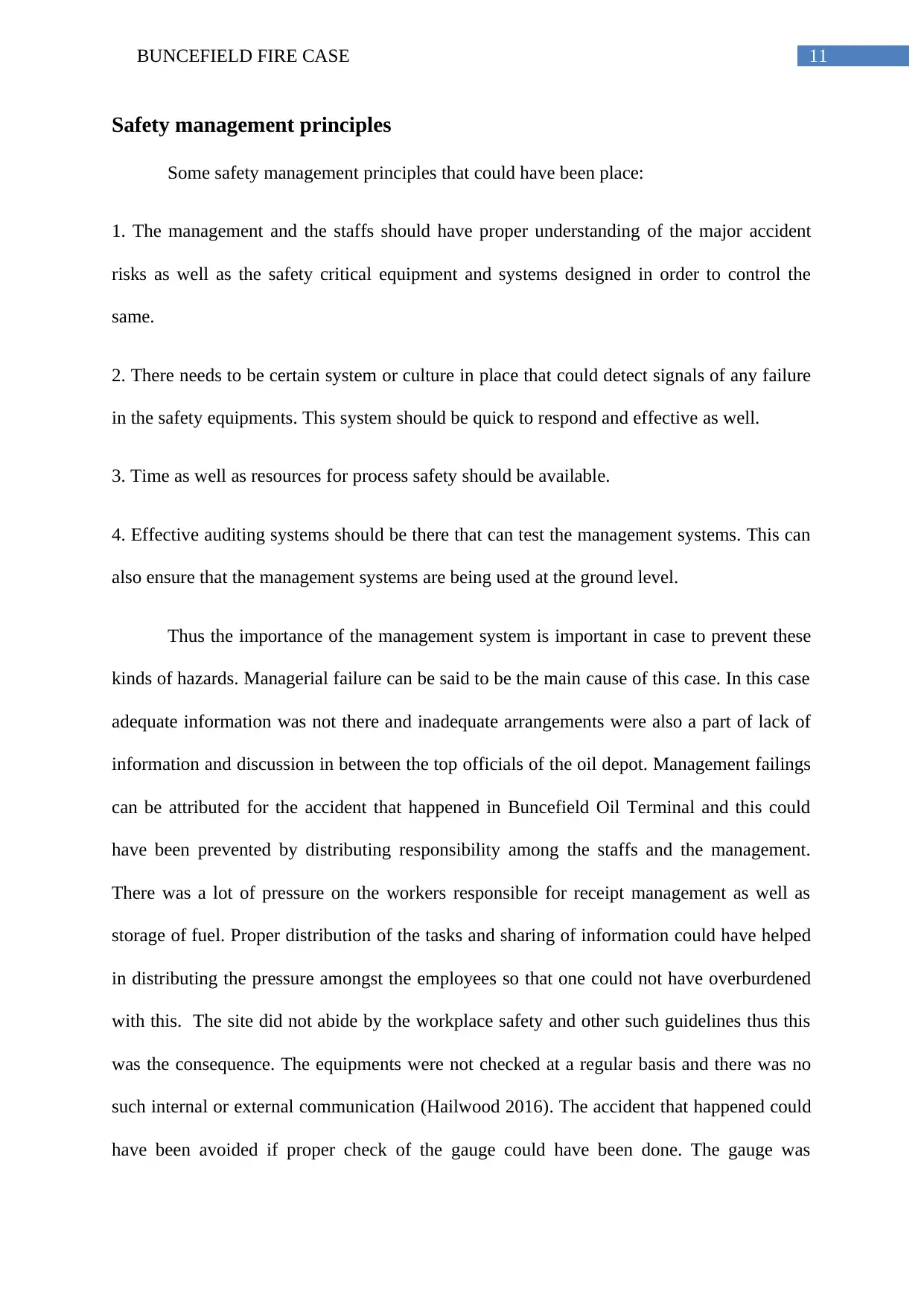
11BUNCEFIELD FIRE CASE
Safety management principles
Some safety management principles that could have been place:
1. The management and the staffs should have proper understanding of the major accident
risks as well as the safety critical equipment and systems designed in order to control the
same.
2. There needs to be certain system or culture in place that could detect signals of any failure
in the safety equipments. This system should be quick to respond and effective as well.
3. Time as well as resources for process safety should be available.
4. Effective auditing systems should be there that can test the management systems. This can
also ensure that the management systems are being used at the ground level.
Thus the importance of the management system is important in case to prevent these
kinds of hazards. Managerial failure can be said to be the main cause of this case. In this case
adequate information was not there and inadequate arrangements were also a part of lack of
information and discussion in between the top officials of the oil depot. Management failings
can be attributed for the accident that happened in Buncefield Oil Terminal and this could
have been prevented by distributing responsibility among the staffs and the management.
There was a lot of pressure on the workers responsible for receipt management as well as
storage of fuel. Proper distribution of the tasks and sharing of information could have helped
in distributing the pressure amongst the employees so that one could not have overburdened
with this. The site did not abide by the workplace safety and other such guidelines thus this
was the consequence. The equipments were not checked at a regular basis and there was no
such internal or external communication (Hailwood 2016). The accident that happened could
have been avoided if proper check of the gauge could have been done. The gauge was
Safety management principles
Some safety management principles that could have been place:
1. The management and the staffs should have proper understanding of the major accident
risks as well as the safety critical equipment and systems designed in order to control the
same.
2. There needs to be certain system or culture in place that could detect signals of any failure
in the safety equipments. This system should be quick to respond and effective as well.
3. Time as well as resources for process safety should be available.
4. Effective auditing systems should be there that can test the management systems. This can
also ensure that the management systems are being used at the ground level.
Thus the importance of the management system is important in case to prevent these
kinds of hazards. Managerial failure can be said to be the main cause of this case. In this case
adequate information was not there and inadequate arrangements were also a part of lack of
information and discussion in between the top officials of the oil depot. Management failings
can be attributed for the accident that happened in Buncefield Oil Terminal and this could
have been prevented by distributing responsibility among the staffs and the management.
There was a lot of pressure on the workers responsible for receipt management as well as
storage of fuel. Proper distribution of the tasks and sharing of information could have helped
in distributing the pressure amongst the employees so that one could not have overburdened
with this. The site did not abide by the workplace safety and other such guidelines thus this
was the consequence. The equipments were not checked at a regular basis and there was no
such internal or external communication (Hailwood 2016). The accident that happened could
have been avoided if proper check of the gauge could have been done. The gauge was
⊘ This is a preview!⊘
Do you want full access?
Subscribe today to unlock all pages.

Trusted by 1+ million students worldwide
1 out of 17
Related Documents
Your All-in-One AI-Powered Toolkit for Academic Success.
+13062052269
info@desklib.com
Available 24*7 on WhatsApp / Email
![[object Object]](/_next/static/media/star-bottom.7253800d.svg)
Unlock your academic potential
Copyright © 2020–2025 A2Z Services. All Rights Reserved. Developed and managed by ZUCOL.





